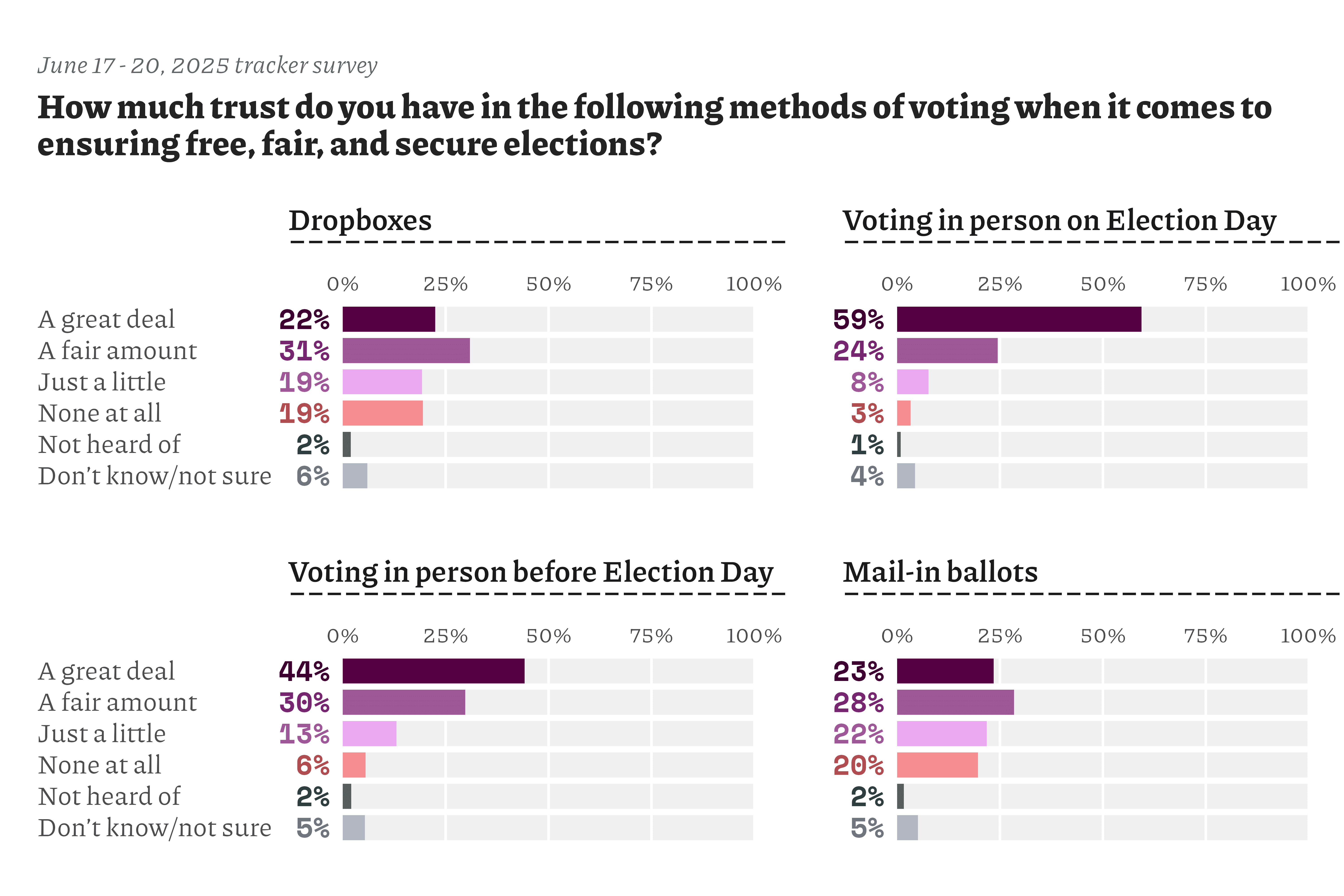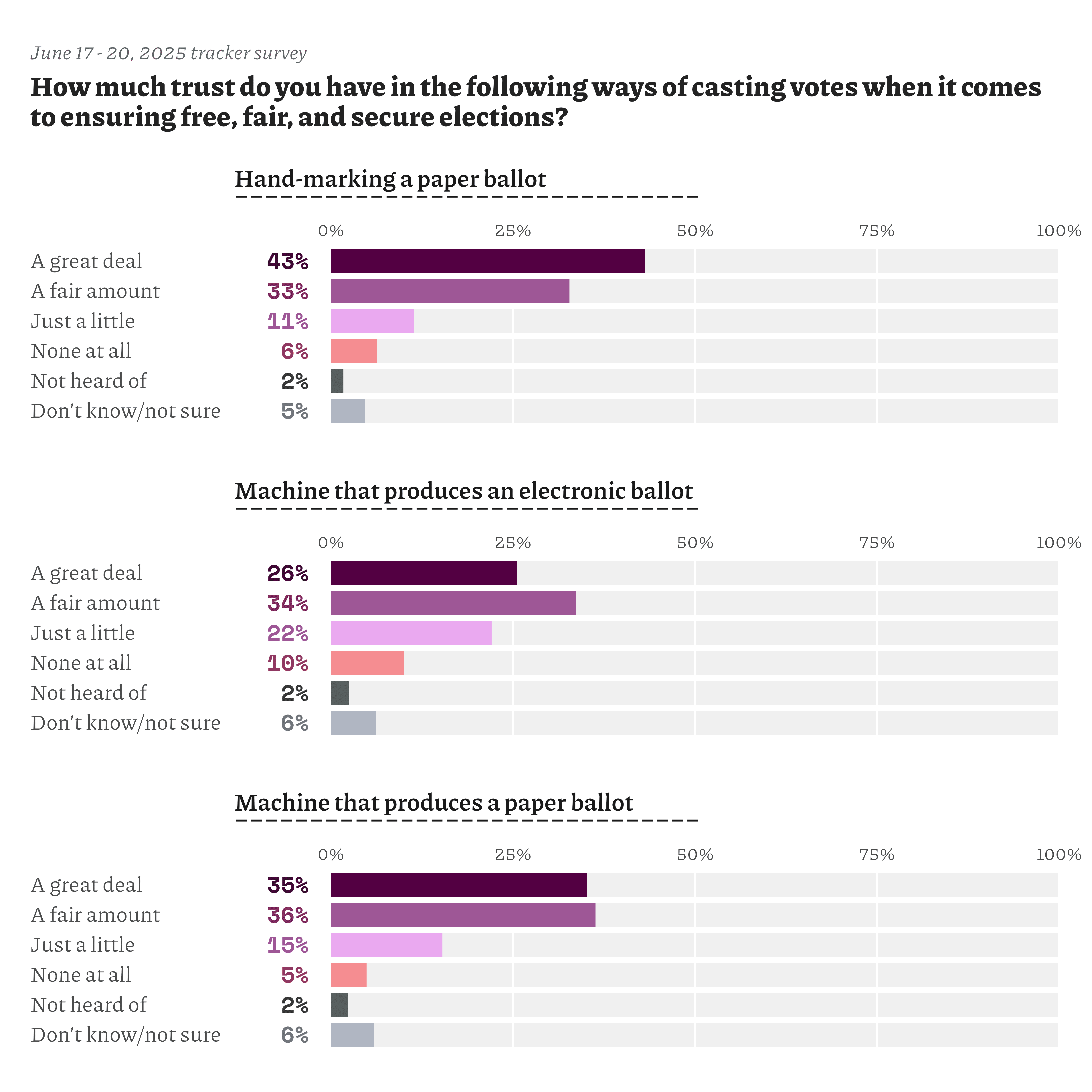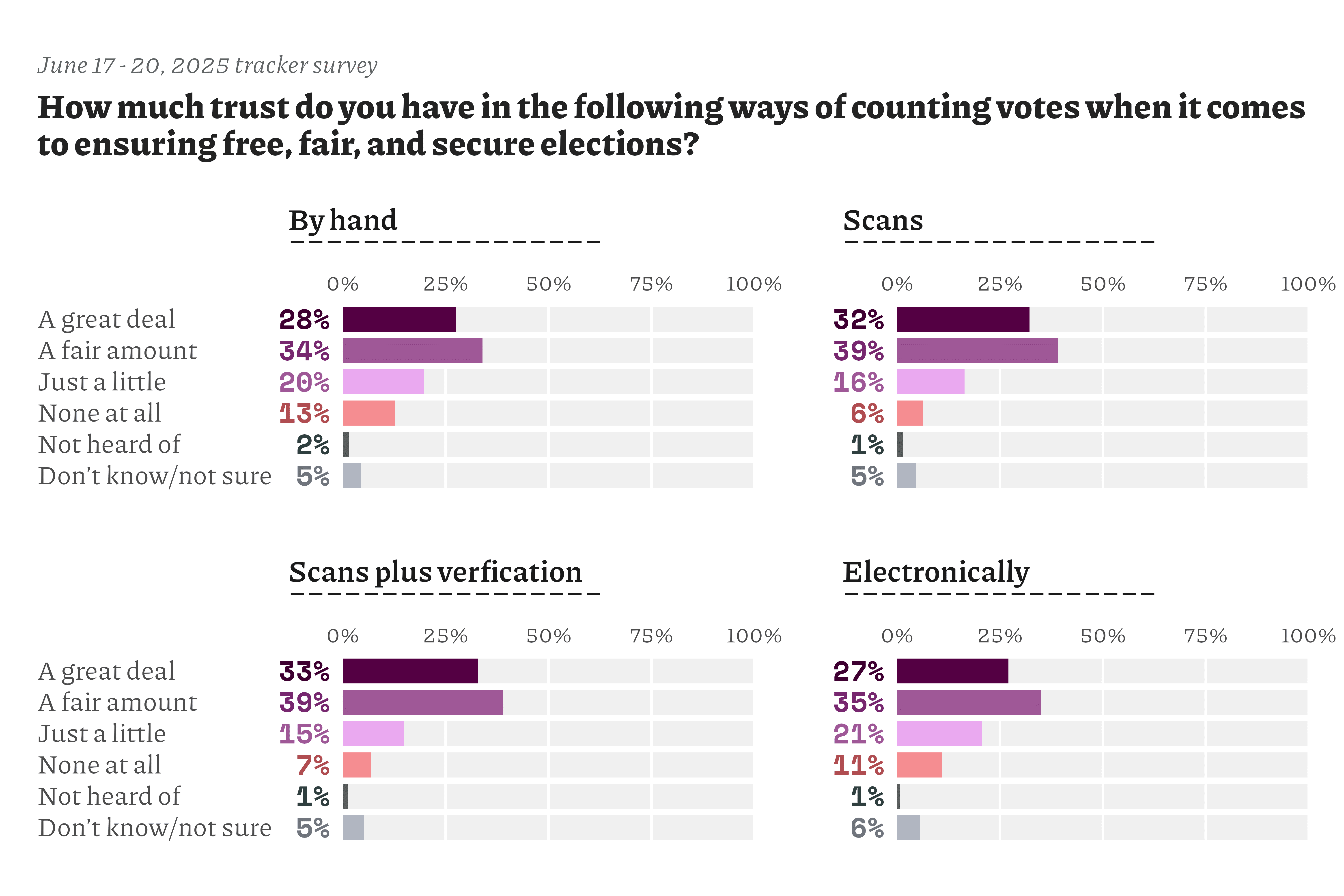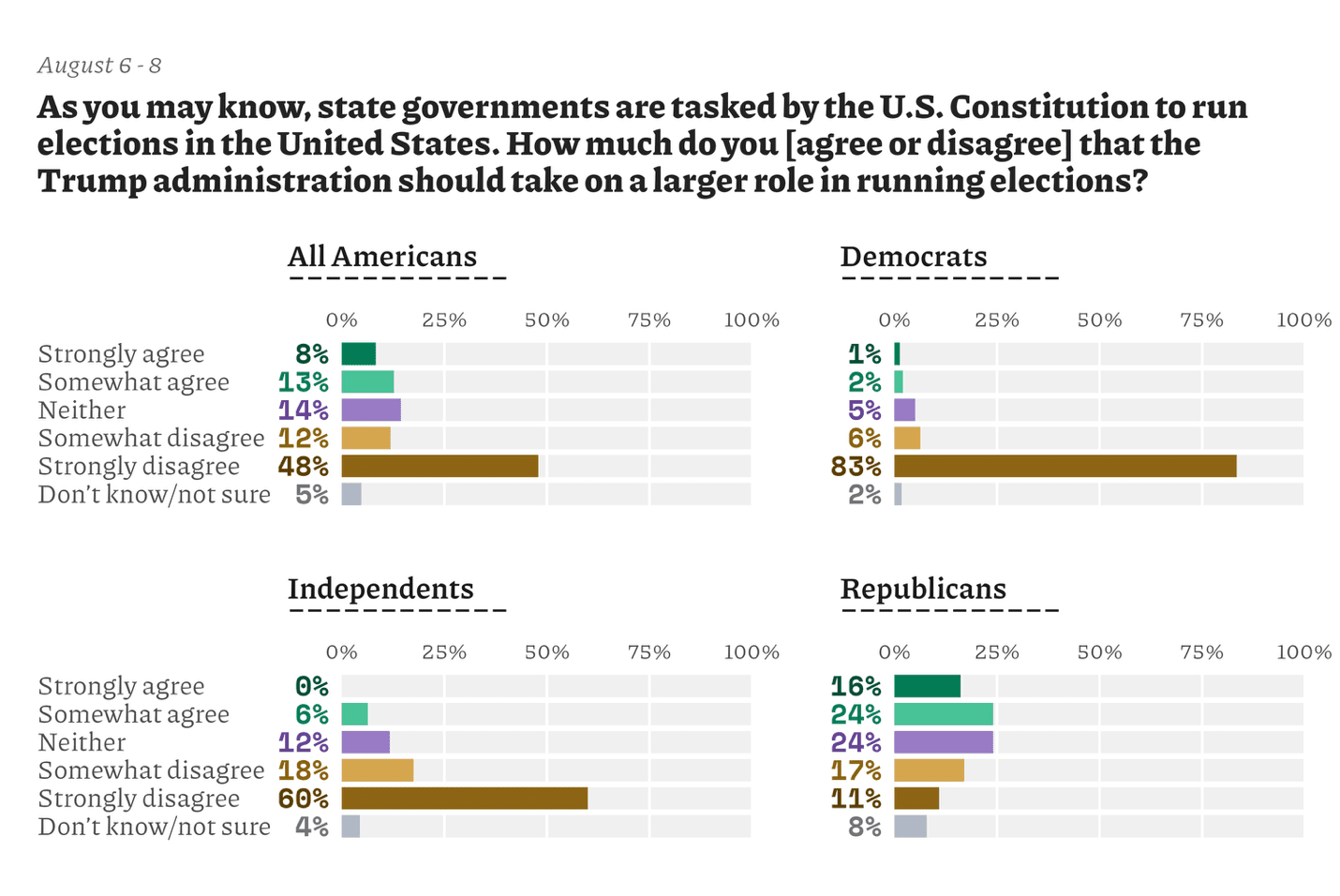Sharing the Facts About the President’s Threat to Ban Vote-By-Mail
President Trump is escalating his hostility toward mail-in voting.
In a series of statements in mid-August, the president said he was going to get rid of mail-in voting and voting machines nationwide, claiming they were inaccurate, slow, and expensive. Trump claimed that states must follow his upcoming executive order in getting rid of them. This would be flatly illegal.
The post was riddled with inaccuracies, including a claim that states “are merely an ‘agent’ for the Federal Government in counting and tabulating the voting,” and that states must follow his orders. In the American system, states run elections.
Voting by mail is widely trusted throughout the country and used by Americans of different ages, political parties, and locations. Though rules vary by state, each has procedures in place to ensure the process is safe and secure.
The president also attacked voting machines. A large majority of Americans vote using paper ballots, and almost every American who votes—including those who vote on machines—does so with a verifiable paper trail, which state and local election officials use in audits and recounts. Election equipment is not connected to the internet.
His announcements came after he met with Russian President Vladimir Putin, who told Trump that the U.S. elections were rigged because of mail-in voting. Trump has continued to inaccurately claim the 2020 presidential election was stolen from him.
- Voting by mail is widely trusted and popular.
- Consistent with surveys over time, polling shows most Americans express either a great deal or a fair amount of trust in each casting a ballot by mail.
- The president’s attacks on voting by mail go against the reality of the situation on the ground. It is widely used and liked.
- Americans trust the ways we count ballots.
- States United polling shows Americans report high levels of trust in different methods of counting votes, including through scans, scans with additional verification, and electronically. The idea that Americans want to change these methods is not backed up by data.
- Americans don’t want the president to get more involved in elections.
- States United polling shows 6 in 10 Americans disagree with the Trump administration’s attempts to get more involved with how elections are run.
- Mail voting is safe and secure. If you choose to vote by mail, state election officials will make sure your vote is counted.
- Any executive order that would ban mail-in ballots and voting machines nationwide would be illegal.
- The president’s only job in elections is to run for office. The Constitution gives states the power to run the voting process. It should concern all Americans when a president tries to change the way elections operate by himself to rig the process for his own benefit.
- Mail voting is popular. Every U.S. state offers some form of mail voting, and its use has steadily grown over time as a convenient way for voters to make their voices heard.
- States have overlapping systems in place to protect the security of mail voting. Procedures vary by state, but those systems include:
- Signature verification, overseen by trained election workers. (In some states, law enforcement conducts anti-forgery training. In some states, questionable matches are sent to a bipartisan review team.)
- Unique serial numbers and bar codes that make sure each voter can return only one valid ballot.
- Verification procedures that make sure each ballot is sent to the correct voter.
- Tracking procedures that let both voters and election officials track every ballot, from when it goes in the mail to when it’s counted.
- Stiff criminal penalties, up to prison time, for anyone who tries to tamper with mail voting.
- Americans care about an accurate vote count. That’s why we’ve trusted machines to count votes for decades. They’re certified, tested, and accurate.
- Modern vote-counting systems are accurate and secure. They are subject to extensive security protections and accuracy checks. And they have to meet strict requirements to be certified for use in an election.
- Those tests include observers from all parties in the race.
- State and local election officials are preparing every day to deliver another election that’s free, fair, safe, and secure. They’ll make sure every eligible vote, and only every eligible vote, is counted.
States United partnered with YouGov on two national surveys—one of 1,515 adults between June 17 and 20 and the other of 1,030 registered voters from August 6 to 8—to better understand Americans’ views on issues, including around election powers and methods of voting and counting ballots.
The June survey found widespread trust among Americans for the ways we cast ballots, including by mail. That survey also showed most Americans trust the ways election officials count ballots, which often involve scanners and electronic machines. The August survey showed that overall, Americans don’t want to see the Trump administration getting more involved in running elections by changing procedures and taking power away from the states.
In the first set of key questions, Americans were asked how much they trusted the following methods of voting when it comes to ensuring free, fair, and secure elections: ballot drop boxes, voting in person on Election Day, voting in person before Election Day, and mail-in ballots. Most Americans showed a great or fair amount of confidence in each method of casting their ballot.

Americans were also asked about their levels of trust in different ways of casting votes. Every way—hand-marking a paper ballot, using a machine that produces an electronic ballot, and using a machine that produces a paper ballot—was trusted either a great deal or a fair amount by a majority of respondents. Hand-marking a paper ballot received the highest marks, with 43% of respondents saying they trusted it a great deal.

States United also asked Americans how much they trust different ways of counting votes. Those included counting votes entirely by hand, using machines that scan paper ballots, using machines that scan paper ballots that are later verified by a hand count, and completely electronically using machines. Again, large majorities of Americans expressed either a great or a fair amount of trust in each.

Finally, Americans were asked how much they agreed with the Trump administration’s push to take more control over American elections, even though the Constitution delegates that power to states. Six in 10 respondents disagreed with the administration’s efforts, including large majorities of Democrats and independents. Republicans were more mixed, with 40% agreeing and just 28% disagreeing.

The data for the trust questions are taken from a States United survey based on 1,515 interviews conducted on the internet of U.S. adults. Participants were drawn from YouGov’s online panel and were interviewed from June 17 – 20, 2025. The data for the question about the Trump administration’s role in administering elections is taken from a States United survey based on 1,030 interviews conducted on the internet of registered voters. Participants were drawn from YouGov’s online panel and were interviewed from August 6 – 8, 2025. Respondents were selected to be representative of American adults. Responses were additionally weighted to match population characteristics with respect to gender, age, race/ethnicity, education of registered voters, and U.S. Census region based on voter registration lists, the U.S. Census American Community Survey, and the U.S. Census Current Population Survey, as well as 2020 presidential vote. The margin of error for these survey is approximately ± 2.7 to 2.8 percentage points, though it is larger for the analysis of partisan subgroups described above. Therefore, sample estimates should differ from their expected value by less than the margin of error in 95% of all samples. This figure does not reflect non-sampling errors, including potential selection bias in panel participation or measurement error.
In keeping with best research practices, we classify independent voters who reported “leaning” toward either the Democratic or Republican parties as partisans. Therefore, “independents” are defined as those respondents who professed no partisan attachments whatsoever.